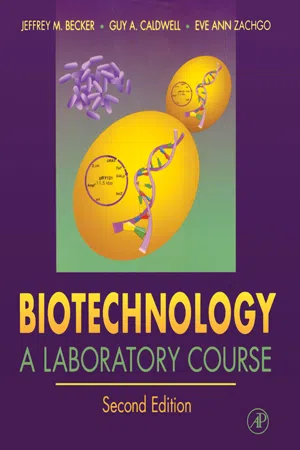
- 261 pages
- English
- ePUB (mobile friendly)
- Available on iOS & Android
About this book
The objectives of this Second Edition of Biotechnology: A Laboratory Course remain unchanged: to create a text that consists of a series of laboratory exercises that integrate molecular biology with protein biochemistry techniques while providing a continuum of experiments. The course begins with basic techniques and culminates in the utilization of previously acquired technical experience and experimental material. Two organisms, Sacchaomyces cerevisiae and Escherichia coli, a single plasmid, and a single enzyme are the experimental material, yet the procedures and principles demonstrated are widely applicable to other systems. This text will serve as an excellent aid in the establishment or instruction of introductory courses in the biological sciences.- All exercises and appendixes have been updated- Includes new exercises on: - Polymerase chain reaction- Beta-Galactosidase detection in yeast colonies- Western blotting- New procedures introduced for: - Large-scale plasmid isolation- Yeast transformation- DNA quantitation- New appendixes added, one of which provides details on accessing biological information sites on the Internet (World Wide Web)- Use of non-radioactive materials and easy access to microbial cultures- Laboratory exercises student tested for seven years
Frequently asked questions
- Essential is ideal for learners and professionals who enjoy exploring a wide range of subjects. Access the Essential Library with 800,000+ trusted titles and best-sellers across business, personal growth, and the humanities. Includes unlimited reading time and Standard Read Aloud voice.
- Complete: Perfect for advanced learners and researchers needing full, unrestricted access. Unlock 1.4M+ books across hundreds of subjects, including academic and specialized titles. The Complete Plan also includes advanced features like Premium Read Aloud and Research Assistant.
Please note we cannot support devices running on iOS 13 and Android 7 or earlier. Learn more about using the app.
Information
Aseptic Technique and Establishing Pure Cultures: The Streak Plate and Culture Transfer
Introduction
Reagents/Supplies
Table of contents
- Cover image
- Title page
- Table of Contents
- Copyright
- Dedication
- Preface to the Second Edition
- Preface to the First Edition
- Acknowledgments
- Suggested Schedule for Exercises
- Introductory Notes
- Exercise 1: Aseptic Technique and Establishing Pure Cultures: The Streak Plate and Culture Transfer
- Exercise 2: Preparation of Culture Media
- Exercise 3: The Growth Curve
- Exercise 4: Isolation of Plasmid DNA from Escherichia coli: The Mini-Prep
- Exercise 5: Purification, Concentration, and Quantitation of DNA
- Exercise 6: Large-Scale Isolation of Plasmid DNA by Column Chromatography
- Exercise 7: Amplification of a lacZ Gene Fragment by the Polymerase Chain Reaction
- Exercise 8: Restriction Digestion and Agarose Gel Electrophoresis
- Exercise 9: Southern Transfer
- Exercise 10: Preparation, Purification, and Hybridization of Probe
- Exercise 11: Transformation of Saccharomyces cerevisiae
- Exercise 12: Isolation of Plasmid from Yeast and Escherichia coli Transformation
- Exercise 13: Protein Assays
- Exercise 14: Qualitative Assay for β-Galactosidase in Yeast Colonies
- Exercise 15: Determination of β-Galactosidase in Permeabilized Yeast Cells
- Exercise 16: Assay of β-Galactosidase in Cell Extracts
- Exercise 17: β-Galactosidase Purification
- Exercise 18: Western Blot: Probe of Protein Blot with Antibody to β-Galactosidase
- Exercise 1A: Isolation and Characterization of Auxotrophic Yeast Mutants
- Exercise 2A: Measurement of pH
- Exercise 3A: Use of the Spectrophotometer
- Exercise 6A: Isolation of Plasmid DNA: The Maxi-Prep
- Exercise 10A: Colony Hybridization
- Appendix 2: Buffer Solutions
- Appendix 3: Preparation of Buffers and Solutions
- Appendix 4: Properties of Some Common Concentrated Acids and Bases
- Appendix 5: Use of Micropipettors
- Appendix 6: Safe Handling of Microorganisms
- Appendix 7: List of Cultures
- Appendix 8: Storage of Cultures and DNA
- Appendix 9: Sterilization Methods
- Appendix 10: Preparation of Stock Solutions for Culture Media
- Appendix 11: Growth in Liquid Medium
- Appendix 12: Determination of Viable Cells
- Appendix 13: Determination of Cell Mass
- Appendix 14: Determination of Cell Number
- Appendix 15: Nomenclature of Strains
- Appendix 16: Glassware and Plasticware
- Appendix 17: Preparation of Tris and EDTA
- Appendix 18: Basic Rules for Handling Enzymes
- Appendix 19: Effects of Common Contaminants on Protein Assays
- Appendix 20: Manufacturers’ and Distributors’ Addresses
- Appendix 21: Surfing the Bionet: World Wide Web Addresses
- Glossary
- Index